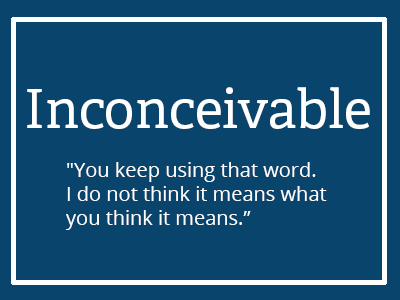Inconceivable! Does Your Marketing Mean What You Think It Means?
Using terms and reference points consistently – and in a way that your customers understand – is a critical task to ensure marketing efforts work for you.
In the 1987 movie The Princess Bride, the notorious Sicilian pirate Vizzini – character foil to the honorable Inigo Montoya – spends much of the film reacting to each new turn of events with an exclamation of “inconceivable!”
Vizzini’s exclamations always either precede or follow something that is, of course, entirely conceivable, much to the frustration of his team. Finally, after one too many of these instances of this commentary, Inigo Montoya tells Vizzini, “You keep using that word. I do not think it means what you think it means.”
 In addition to creating one of the most memorable movie lines of all time, Montoya’s trenchant response summarizes a common problem we often overlook: We don’t all use words in the same way. There are several studies of linguistic trends within the United States (e.g. do you drink pop, soda or Coke?), so it should come as no surprise that business has micro-cultures of language meaning as well.
In addition to creating one of the most memorable movie lines of all time, Montoya’s trenchant response summarizes a common problem we often overlook: We don’t all use words in the same way. There are several studies of linguistic trends within the United States (e.g. do you drink pop, soda or Coke?), so it should come as no surprise that business has micro-cultures of language meaning as well.
Using terms and reference points consistently – and in a way that your customers understand – is a critical task that requires training and communication. In fact, even the language of evaluating what your team knows and what it doesn’t know in order to prepare for training can be fraught with confusion. Is your team taking a “marketing assessment” or a “knowledge diagnostic” Do they need a “skills refresher” or a “skills upgrade?” What’s the difference? Does it matter?
Well, the right terminology does matter, but not in the ways you might expect. In the Learning division of SiriusDecisions, we work with a wide variety of clients on their training and assessment needs, and here is what we’ve found:
- Telling an educated workforce what words to use and what concepts mean within the company is awkward; thus, many companies avoid doing it. To ask an accomplished adult you esteem enough to hire to sit through a “Company Terms and Usage 101” presentation can seem bureaucratic and pedantic, especially for new hires of senior rank. Many organizations assume it is easier for employees to simply pick up on any variations on the job.
- Internal inconsistencies show up externally, and it confuses clients. Think about the best Web site you have ever visited. Now, imagine if every time you clicked on the site, it loaded in a dramatically different font, with all the colors reversed, and the images rotated 25 degrees. Would your experience be as positive? Likewise, even small differences between how sales and marketing present to buyers and explain your products can result in unprofessional distractions.
- B2B terminology is different from what many are taught in university business courses or B2B organizations. We discuss this fact among ourselves in the B2B world, but do we apply solutions to it internally? Do we help our B2C colleagues transition their expertise quickly and wisely into a B2B framework?
The good news is that addressing these gaps is relatively easy. Here are some training tips to consider:
- Training shouldn’t be pedantic and/or bureaucratic, even if it reviews known material. When content is designed for the way the adult brain learns best, it can be a welcome primer to help employees feel engaged and understand company culture quickly, increasing their odds of success and ability to adapt. Well-designed e-learning courses should affirm the employee’s existing knowledge while filling any gaps.
- Cross-training between sales and marketing or among marketing departments can spark useful discussions. These discussions can enhance communications with clients, as well as organically reveal any differences in language, terms and positioning that various teams may unintentionally have.
- Assessing skill levels – on both an individual level and a departmental level, helps create a solid training plan. In SiriusDecisions Learning, we strongly believe in the value of well-calibrated self-assessments for team members and team managers, because the resulting gap analysis often reveals a direct and cost-effective training path.
What strategies do you use to combat the “inconceivables” in your organization?